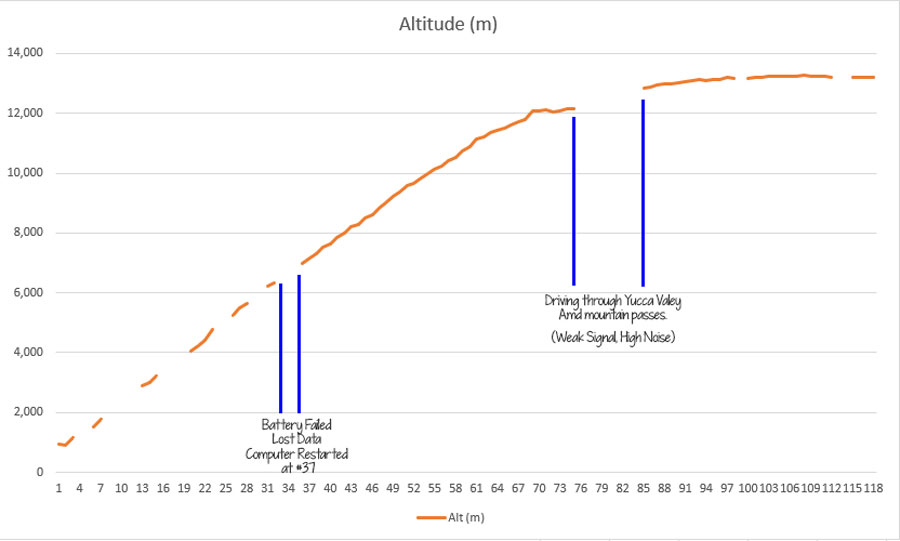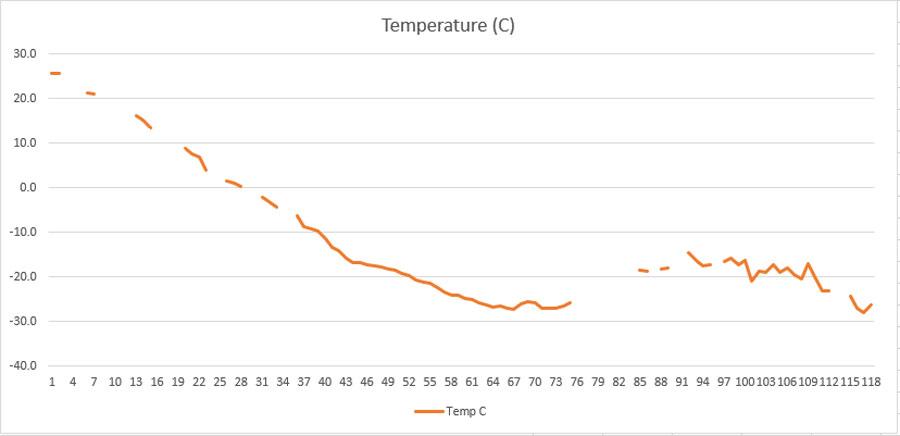FS#1 – Flight Telemetry Data
The Flight of a Brave Squirrel
I spent time cleaning up the FS1 Telemetry data and turned it into and Excel spreadsheet and the following graphs.



The FSQCal program we used to decode the FS1 telemetry will record all the perfect message packets into the file fs1.txt as part of the protocol, however often a very slight bit of data is “off” so it does not get recorded to the file, however it often remains visible on the screen display and can be captured that way as well. Combining the file and screen data in to an Excel file most of the telemetry data was recorded.
About an hour and a half into the flight, the laptop battery failed suddenly so the computer halted and the valuable screen data up to message #34 was lost. Messages #35 & #36 were also lost because the laptop was undergoing a battery change and reboot. Had the battery not failed, much of the missing data before message #34 would have been recovered from the screen data. Failure is part of learning and this problem will be addressed on the next flight.
Starting with Message #37, the data is more complete because I was able to combine the two sources of data, yet there are a few gaps due to random bad reception.
Around the time message #52 was decoded the radio signal had diminished so a low level (S3). Before the signal disappeared, I left the launch site and started to chase FS1 Eastward down Hwy 247 towards Banning Pass and the I-10 Fwy (Where the big windmills are). As I chased, the signals improved(S5) This route passes through the town of Yucca Valley, CA which had a very high noise level on the radio preventing reception of the weak FS1 signal. After leaving town the route then passes through very steep and narrow mountain pass, weakening any signals. As a result, messages #76 through #84 were not received and decoded. Once I descended out of the pass the signal returned to a S5 level and telemetry was decoding again. As I headed East to Indo, CA the signal raised up to an S7 and then back downward to S3.
Despite the missing data points, the graphs show clear trends to the end. The temperature graph started going back up just before I lost contact at Yucca Valley and was higher once I had the signals again near I-10. From that point on the temperature was trending down again, but somewhat erratic. During the same time the Pressure and Altitude remained on trend, so I don’t know what was going on. Was it real data or an issue with the temperature sensor?
The last Message #118 was received and decoded around 3:50Pm PST. Nothing more was heard after that message.
We don’t know how where the balloon was when the signals were lost, but it was in flight for nearly 4 and a half hours and at 8.24 Miles in altitude. I suspect it was near the Salton Sea (As was predicted). For a very low power telemetry transmitter (20 Milliwatts) it performed very well at those distances, no matter where it was.
The goals of the FS1 mission were broadly, 1. Have fun and 2. Learn stuff. The launch team certainly achieved the first goal. We also learned stuff and I will comment in more detail in another post soon.
73 de KJ6FO Don

2 comments to “FS#1 – Flight Telemetry Data”
John Deamer - January 20, 2018
Well done, Squirrel Dad. A highly successful flight. One question comes to mind: did you add a battery heat source to increase battery charge life?
admin - April 5, 2018
Sorry for the very prolonged delay in responding.
FS1 was, by design, not insulated. My goal was to learn what would fail in the cold, so I could make improvements on the next mission. So, no the battery was not kept warm at all and this certainly had the effect of reducing battery output and probable death of the battery by freezing.
FS2 is in final design and will be insulated. Details are still being sorted out how to insulate the package without adding too much weight. I am expecting that the electronics will create some heat and hopefully that heat can be retained enough to prolong the mission. The battery will be located in the middle of the package so best absorb heat and avoid the outside cold.
Thank you for your question,
73s KJ6FO